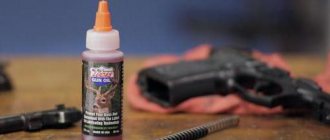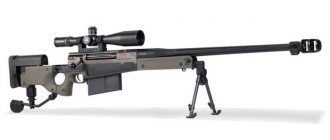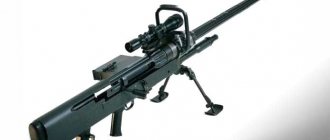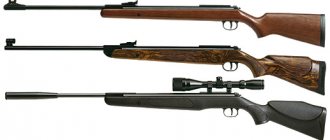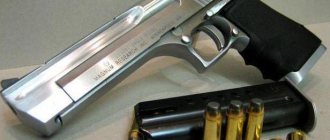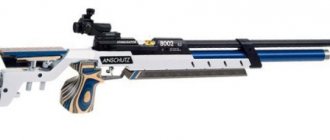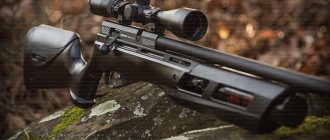MAKSIMOV.SU
In this article we will return again to the topic of small-caliber weapons, which still maintain traditional popularity in Russia.
We discussed the reasons for this in previous articles.
Today
we will talk about one of the best examples of sporting and hunting small-caliber long-barreled weapons of domestic production, which is based on the bolt group used in Soviet sports rifles for biathlon. Meet the 5.6 mm Izhevsk sporting and hunting carbine “Sobol”.
It’s the beginning of spring 2020,
accompanied by the height of the information war, new anti-Russian sanctions, the gathering of NATO troops to our borders and growing uncertainty.
The secondary market is already full of imported carbines, although suppliers are trying to solve the problem with cartridges by hook or by crook. Small-caliber rifle "Sobol"
Nevertheless
, Russian hunters, having already fully tasted all the bitterness of problems with Western-made cartridges, are increasingly turning to Russian weapons. In this case, those who have an imported carbine with a caliber for which our factories produce ammunition are lucky.
Small caliber cartridges
have always been produced in Russia, and the quality of our 5.6 mm cartridges is still quite acceptable for solving almost any range of problems, both for hunters and athletes. And Russia still produces 5.6-mm rifles that are excellent in terms of their performance characteristics, attractive both in appearance and at relatively low cost.
Small-caliber rifle
"Sobol"
“Sable”
History and design features
Description of the carbine by the manufacturer:
“The carbine is designed for hunting small animals and birds. For shooting from a carbine, 5.6 mm (.22 LR) rimfire cartridges of domestic and foreign production are used. The barrel bore is locked by a crank locking mechanism with vertical axes of rotation. Reloading is done manually with cartridges supplied from the magazine.
Mechanical sight
designed for 25 and 75 meters. The receiver has a dovetail base for mounting an optical sight. The design of the carbine allows you to fire from a mechanical sight without removing the optical sight.
Small-caliber rifle
"Sobol"
Carbine stock
can be made from various types of wood (birch, walnut, beech). The bullet dispersion diameter is average when firing at a distance of 50 m with “Match” cartridges in 3 series of 5 shots, no more than 25 mm. Magazine capacity: 5 rounds. The weight of the carbine without an optical sight and accessories is no more than 3 kg.”
Small-caliber rifle
"Sobol"
The main difference between Sobol
from the classic “little things” - the use in its design of the above-mentioned crank-type bolt, which allows you to shoot very quickly and with minimal disruption to manufacturing. The progenitor of the Sobol is the biathlon 5.6-mm rifle Bi-7-2, famous for its characteristics, produced by IZHMASH since 1980.
Shutter application
new type opened a new era in shooting sports. Currently, such a bolt is used by all the world's leading manufacturers of sporting weapons. This design made a revolution in bullet shooting almost a hundred years after its appearance in machine guns of the H. Maxim system, a rare Henry-Winchester rifle and such little-known exotics as Volcanic pistols.
After
this original locking concept was used by H. Borchardt in his pistol of the 1893 model, which became the prototype of the famous Parabellum.
Small-caliber rifle "Sobol"
Receiver of the weapon, top view. Note the iron sight, dovetail and bolt axis
Everything else in Sobol
differs little from a regular small-caliber rifle, with the exception of a really useful option - the presence of 2 spare magazines in special sockets of the butt - a legacy of the sporting past.
As a rule, even for commercial hunting, 3 magazines of 5 cartridges each are more than enough, but you need more - so a spare pack of tiny cartridges does not fit your pocket. Small-caliber rifle "Sobol"
But when
There is only one magazine attached to the rifle, then its loss at the most inopportune moment turns the rifle into a single-shot one. And here - a couple of spare magazines are always securely attached to the butt, in addition, they are often found on sale and cost several times cheaper than magazines for imported small ones.
Small-caliber rifle "Sobol".
Very convenient: in the butt of the rifle there is a compartment with two spare magazines. The idea is not new. This kind of NC in the form of sockets for spare cartridges can often be found in the butts of old European fittings
Sable at work
In hand
This carbine feels almost like a toy. This impression is partly created due to the unusual bolt of the weapon. It is necessary about the “Legion” version of the “Premier”, which has a walnut stock, looks and feels much more solid than copies with a birch stock. Still, the type of wood of a rifle butt matters.
The shops
They load easily and attach to the weapon without effort. The action of the shutter is quite soft even on a new rifle. During operation, all moving parts become worn in over time. Well-fired rifles of this type have a very pleasant “buttery” bolt stroke.
However,
If you have metalworking skills, you can put your hands on the rifle a little from the very beginning. The trigger force may seem a little high for sport shooting; here you either need to get used to it or, again, modify the trigger yourself or, preferably, in a licensed workshop with a good reputation.
When reloading the Sobol, the shooter is free from the risk of getting hit in the eye with his own fist.
Especially with a significant focus shift of the optical sight. KAHLES KXi 3.5-10x50 L with 4D-Dot mesh is perfect for “small things”
Small-caliber rifle "Sobol".
The
straight-line movement of the shutter allows the use of optics of any size on rings of any height, including the lowest (in our case, the monoblock turned out to be high, but there was no other one at hand)
Small-caliber rifle "Sobol".
Chuck on the feed line. Thanks to the special features of the shutter, reloading occurs quickly and without losing the target from the field of view
Sights "Sable"
are suitable only for solving the simplest hunting tasks and, given the potential of the rifle and the presence of grooves for mounting an optical sight, are a constructive palliative.
But this
It’s not scary: if the Sobol is purchased exclusively for sport shooting with optics, it makes sense to completely dismantle the front sight and rear sight. Then the sight can be installed as low as possible, at the same time simplifying the task of selecting fasteners.
Small-caliber rifle "Sobol".
The two-position rear sight is compact, convenient and has 2 positions - at 25 and 75 m.
Small-caliber rifle "Sobol".
The muzzle of the barrel has a high-quality “crown”. The adjustable front sight is reliably protected by a removable front sight
Recoil from Sobol
practically absent, the shot is quiet, thanks to the design features of the bolt, it is a pleasure to shoot from the Izhevsk carbine. Small-caliber weapons require the shooter to have some experience and very specific skills (if we are talking about shooting at distances that are more or less decent for a 5.6 mm cartridge), but if you have a good stop, getting good results from the Sobol is not a problem.
Many
Sobol owners install a bipod on their carbines, a permanent or adjustable comb on the butt, order a new orthopedic stock, etc. I must say that tuning an accurate “small thing” is a very exciting and productive process. Taking into account the acute lack of normal open shooting ranges in our country (probably, the shortage of land still has an effect), having a small-caliber rifle in the safe means much more opportunities for training.
Indoor
50-m shooting galleries (useless from the point of view of owners of “real” rifles) are quite common in large cities, but for a “melkan” this distance is the most optimal.
Small-caliber rifle "Sobol".
The fuse is located in a polyamide trigger guard and is convenient to use
Small-caliber rifle "Sobol".
Stamps on the receiver of a weapon. Pay attention to the bracket stopper (in this case, it is necessary given the peculiarities of mounting optics on a weapon, but is not used)
Conclusion
So let's see
What do we have in the bottom line? In terms of its operational characteristics, the Sobol is a very attractive weapon. The relatively low cost of the Izhevsk carbine today makes it more than competitive (at the beginning of 2020 - within 20-25 thousand rubles, depending on the region).
Certainly,
the Tula 5.6-mm TOZ-78 is cheaper, but it is a weapon of a different class and type, despite the examples found with very good combat. Thanks to its high accuracy and rate of fire, the Sobol can be successfully used for recreational sports shooting, including the increasingly popular small-caliber benchrest.
Rifle
It shoots well out of the box, but always has the potential to achieve better results and good opportunities for tuning. There is a lot of practical information on improving Sobol in the public domain, especially on the Internet.
Small-caliber rifle
"Sobol"
Speaking about tuning the Izhevsk “small car”,
First of all, we mean selecting the optimal bracket for the optical sight and the optics itself. Despite the insignificant recoil of a small-caliber rifle and the relatively short firing range from it, the choice of an optical sight must be taken as responsibly as possible.
Practically
all owners of 5.6 mm rifles start with low-power budget optics like 4x32 “Pilada” from VOMZ or, which is absolutely no good, “Chinese” ones of dubious quality. I admit honestly, I once went down this dead-end path from the very beginning, the results of which could only be acceptable for a certain type of hunting.
As
improving the skill of shooting from “small guns”, and it is improving quite quickly, the need for shooting at maximum distances for a 5.6 mm cartridge is also growing, which entails the need for a stronger magnification of the sight and a high level of its optical-mechanical characteristics.
“Sable” has very graceful outlines,
in which the thoroughbred nature of the weapon and high potential
Often
On high-precision small-caliber rifles you can see a sight, the price of which is several times higher than the cost of the weapon. Today this is becoming the norm, but art requires sacrifice. In our case, when installing the Austrian KAHLES KXi 3.5-10x50 L sight with a 4D-Dot reticle on the domestic Sobol, the difference in the price of the weapon and optics became mind-boggling.
But
this inequality was fully compensated by the quality of the “picture” of the sight, the convenience of the aiming reticle, and improved shooting results. At the same time, the first bracket that came to hand was taken - a duralumin squalor of American-Chinese origin.
But its function
he performed quite well. At least at a 50 m distance, using Klimov cartridges to hit a modern 10-kopeck coin was not a problem.
Small-caliber rifle "Sobol",
view from the shooter's side
The only drawback of "Sable"
- this is the need to remove the optics when disassembling the weapon to clean it. But, firstly, you don’t have to disassemble the carabiner; you can just clean it with a flexible cleaning rod or, the old-fashioned way, with a fishing line and a piece of rag. And secondly, after removing/installing the sight, the STP moves extremely slightly or does not move at all (if there is a high-quality bracket).
More
It would be nice to have a weaver bar instead of a “dovetail” on the receiver (as on the “Sable” modification for the American market called “Basic”), but the “dovetail” is used on many “small guns” from well-known manufacturers, incl. and CZ, so no big deal. And the choice of brackets and rings for the “flipper” is more than extensive. Best shots to you!
Small-caliber rifle "Sobol".
To remove the magazine, just press the “back” key; the magazine can be removed easily and quickly
The article was published in the magazine “Hunting”, April 2020
Production
Hunting pneumatics. Air instead of gunpowder. (magazine “Hunting”, 03.2012)
For hunting, air rifles with a caliber of 9 millimeters or more have long been created and successfully used, making it possible to hunt medium-sized animals. But this is behind the “hillock”; they even hunt with revolvers. How are we doing with hunting pneumatics? Pneumatics for hunting?
If you pick up the ROH permit for the right to store and carry smooth-bore weapons, you can make sure that such permits are also issued for hunting pneumatic weapons. However, most hunters perceive “pneuma” only at the level of associations with the “air gun” from the Soviet shooting range, suitable only for shooting sparrows. The fact that there are air rifles of the hunting class has not yet found the proper response in the domestic hunting community, which, in fact, turned out to be surprisingly conservative. And hunting with “pneuma” as such was simply prohibited in our country.
The Supreme Court of the Russian Federation decided to cancel the ban established by the Model Hunting Rules on the use of pneumatic hunting weapons (with a muzzle energy of no more than 25 J) in hunting. And the new edition of the law “On Hunting” allowed us to hunt with air guns.
PCP - abbreviation from English - Pre-Charge Pneumatics, i.e. - a system with preliminary gas injection into the reservoir of an air gun. Such pneumatics have been known for more than 200 years, but have become widespread only recently.
From the Decree of the Government of the Russian Federation of January 10, 2009 N 18 “On the extraction of objects of the animal world classified as hunting objects” (as amended on February 25, 2009): It is allowed to use hunting pneumatic weapons with a muzzle energy of no more than 25 J for the extraction of chipmunks , ground squirrel, sand squirrel, hamster, water vole, as well as hazel grouse and certain species of steppe and field game.
Design Features
A modern air rifle is a fusion of high technology and the latest design solutions. Of course, the basic principle was and remains the same. It’s just that all the components of an accurate shot are practically brought to perfection.
This is fully facilitated by the lack of recoil on PCP rifles. From this we immediately get several benefits - the ability to use any optics, any mounting rings and any return groups. But, paradoxically, here the very purpose of using pneumatics puts forward increased demands on both optics and all other components.
Until recently, English manufacturers were the leaders in the field of high-precision PCP pneumatics. But just a few years ago, the palm was seized by our domestic manufacturer, known to Russian fans of hunting and sports pneuma as “Demyan”, and today appears under the brand name “ATAMAN”.
It can be stated that in Russia today the best PCP-pneumatic weapons in the world are being created, in the development of which the legendary Khaidurov Efim Leontyevich is directly involved (as chief designer), and produced on the most modern equipment. Using the example of ATAMAN products, we will consider the design of a modern PCP rifle.
One of the most interesting developments was recently seriously modernized and received the index “M2 (R)”. Based on this design, several areas of high-precision pneumatics have been created - from compact rifles built according to the bullpup scheme, to specialized sports products, with all the corresponding attributes in the design, in calibers 4.5 mm, 5.5 mm and 6. 35 mm. According to the Law “On Weapons”, M2 is produced in 3 types: the first 2 types, without an index (in any caliber, with muzzle energy from 0.5 to 3 J) and with the index “F” (caliber no more than 4.5 mm and with a muzzle energy of no more than 7.5 J) and with the index “N” - a hunting pneumatic weapon with a muzzle energy from 7.5 to 25 J, sold under license.
Let's focus on the most “hunting” options: carbines (the bullpup system is optional, although it is often more convenient for hunting).
With a length of 980 to 1100 mm, the air carbine (without optics) weighs like a small-caliber rifle (from 2.7 to 3.3 kg, depending on barrel length). The basis of the design is the receiver, made from a single piece of D16T alloy using multi-stage precision processing. The box contains the usual bolt action, cocking the firing pin, which has 2 springs. In the window of the box there is a quick-detachable automatic drum magazine for 8-12 bullets (depending on the caliber). A Picatinny rail is milled on the top of the box, allowing you to quickly and securely install any optics. The mechanical trigger mechanism has adjustments to the stroke, force, angle and location of the trigger. All USM parts are made of high-quality steel and have undergone appropriate heat treatment. The transverse fuse blocks the main and intermediate sear. The stock is designed taking into account all ergonomic requirements (according to the purpose of each rifle model) and is made of walnut.
The barrel block contains a barrel with an integrated separator, while the entire structure ensures maximum rigidity and stability of the barrel when fired. The length of the barrel itself, which has 8 grooves, is from 420 to 520 mm. Under the barrel block of the rifle there is a high-pressure reservoir (safety margin up to 300 atm.), which has a built-in reducer (pressure regulator), superior to most world analogues and allowing you to maintain the same parameters for all shots.
A pressure gauge and a filling port with a valve are mounted in the front plug of the tank, allowing you to quickly and reliably fill the tank from an external source of compressed air.
Depending on the settings, the number of shots from one refill ranges from 30 to 150. Summary
Few people know that pneumatics have been used as weapons since the Napoleonic wars. And even then an air rifle was a complex and delicate instrument. In addition to the advantages in accuracy and rate of fire, pneumatics also had such undoubted advantages as the absence of smoke and insignificant sound when fired.
In the modern world, including now here, air guns are increasingly used not only for sports, but also for hunting. The legal framework for the use of pneumatics for hunting purposes is being gradually developed, the production of high-quality domestic pneumatic weapons is increasing, and the level of training and equipment of shooters is increasing.
Hunting with air rifles is significantly different from hunting with firearms.
It would seem that the most common caliber for PCP rifles - 5.5 mm - coincides with the caliber of the well-known “small rifle”. However, there is a difference and it is huge. There is also a significant difference in the mass of bullets, their initial speed and accuracy potential. And most importantly, an effective aerial shot requires serious equipment: you need a good optical sight, a rangefinder and gas stations are required. You can't do without high-quality bullets and good shooting training. And only then does a modern PCP rifle turn into an accurate and effective tool, the potential of which our hunters have yet to fully appreciate. The article was published in the magazine “Hunting”, in March 2012
Small-caliber rifles "Anschutz"
It is impossible to find among shooters, regardless of the heights they have achieved in the art of shooting, someone who does not remember their first steps in this noble occupation. Someone's shoulder might ache when they remember their first experience with their father's shotgun. Most will fondly remember, as their first love, a weapon with some kind of non-combat and domestic, truly popular name “small thing”. The first shot, the joy of hitting the target for the first time, which became a tangible step in the development of a real man. It is impossible to forget in the palm of your hand the weight of the first, albeit small, but completely real cartridge received at the school shooting range. Previously officially called the 5.6mm "sporting/hunting" or "target" cartridge, it is now better known by its historical name, the .22 LongRifle. Previously, in order to experience the joy of shooting from such weapons, it was necessary to become a commercial hunter or a discharge athlete and visit the shooting range at strictly established training times, now it is enough to obtain a license, visit the nearest weapons store and purchase any sample you like from the many available today on sale. Learning to shoot accurately is not an easy task and requires regular practice. And the ability to always hit the target is a quality that distinguishes a real man. In this regard, a good rimfire rifle is an ideal training tool. The low cost of high-quality small-caliber cartridges does not overshadow or shorten the pleasure of shooting with thoughts of mortal things, and the soft, almost ephemeral recoil will not remind you of itself with painful sensations in the shoulder while drinking a cup of morning coffee. With every shot, the thought of reducing the life of the weapon due to barrel wear does not weigh heavily on the heart. With proper care, a high-quality small-caliber rifle will outlive more than one generation of owners, making the heirs proud of their ancestors. Regardless of the purpose of purchasing a rifle chambered for a small-caliber cartridge, be it improving your skills in bullet shooting and participating in sports competitions, amateur or commercial hunting for small animals and birds, or just shooting at your leisure, the more accurate and reliable the weapon, the greater the pleasure from shooting. , as strange as it may sound, it looks more elegant and beautiful. After all, any weapon is not only a working tool, but also a source of special pride for every owner. Moreover, in our special reality, with a purely Russian limit of smooth-bore and rifled weapons (5 and 5), the question of choosing a weapon is not only not simple, but sometimes very painful. No car or cell phone, which have become standard business cards of wealth, will say as much about the owner as a modest but elegant rifle with the mark of a well-known company.
There are not many high-quality small-caliber rifles on the Russian market. Of these, the most famous are undoubtedly rifles from JG Anschutz GmbH & Co. KG- "Anschutz". The rifles of this respected German company, located in Ulm, the heart of the German arms industry, became known primarily for the champion results achieved with their help in the highest level sporting competitions in shooting and biathlon. But the specific appearance of a rifle for big sport, like haute couture clothing, for all its sophistication and attractiveness, is in fact of little use in everyday life.
Therefore, in the rifles of the 1700 and 1416/1415 series, offered for the civilian weapons market, the same famous barrels, bolts, and the same trigger mechanisms, ensuring exceptional accuracy of each shot, are placed in a more familiar and comfortable classic-type stock. produces 1700 series models chambered for .22 LR, .22 WMR, .22 Hornet cartridges. .222 Rem. Naturally, after production, each rifle of the 1700 series undergoes mandatory shooting at the enterprise’s shooting range, and the target with the result is pasted into the weapon’s passport. Barrels, even in the slightest degree, that do not meet the high requirements are mercilessly rejected even before the assembly stage. The design of the bolt has been mastered by the company since 1935, since the start of production of small-caliber rifles for initial military training ranges, and is continuously being improved. It differs from the bolt of the internationally recognized Mauser combat rifles and carbines only by its smaller size and the absence of the combat lugs necessary for powerful cartridges. In addition, the reliability of weapon reloading is also ensured by a specially designed ejector and extractor, which have proven their reliability in low temperature conditions on biathlon rifles. In general, the 1700 series is positioned as the most prestigious and, accordingly, expensive among others.
One of the new products in the 1700 series was the Model 1717 rifle chambered for the new .17 Hornady Magnum Rimfire (HMR) side firing cartridge with a muzzle velocity of 780 m/s. Shooting at 100 meters in groups of five shots showed a bullet spread of 9-15 mm, which is a serious competitor to the closest competitor, the .17 HMR cartridge, the .22 WMR.
Models of the 1416/1516 series are positioned in the middle price level and are chambered for .22 LR and .22 WMR cartridges. For rifles in this series, the safety is located to the right of the receiver and, when turned on, blocks the trigger. Rifles of the 1416/1516 series are also available in a left-handed version.
The 525 series model is a semi-automatic carbine. Mainly used for leisure shooting, although it can be used on goose/duck flight - but exclusively for picking up wounded animals. The receiver is made of light alloy. Its peculiarity is this. that the installed optical sight is not recommended to be removed frequently due to the possibility of slight deviation of the aiming mark. The safety on this model is located on the right side of the trigger guard. The undoubted advantage of the 525 series rifles is their compactness when disassembled. If necessary, the rifle can be quickly disassembled into two parts: a stock with a receiver and a barrel with a forearm only 610 mm long. Precise and reliable connection of both parts is ensured by one hex head screw.
Any of the rifles will never disappoint or let down even the most experienced shooter and will become his reliable friend. The company pays serious attention to the Russian arms market. Since September 25, 2001, a representative of the company JG Anschutz GmbH & Co. KG became the Okhotnik on Golovinsky store.


